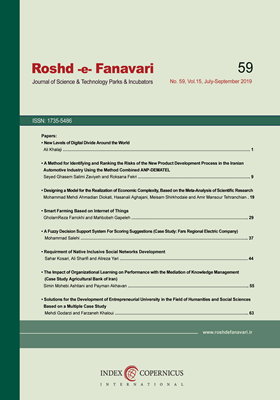New Levels of Digital Divide Around the World
Subject Areas : Technology Development Infrastructures and Supporting organizations
1 -
Keywords: Digital Divide Access Gap Usage Gap Knowledge Gap Digital Inclusion Production Gap,
Abstract :
This paper examines the concept of digital divide at the global level and within the countries level. To this end, we have been studying and analyzing research on digital divide in different countries and using international statistics. The research results show that the digital divide is a broad, complex, multidimensional concept and beyond physical access to communication technologies. The digital divide,which is posed in two spheres,first international and among different countries and within the countries , can occur at four levels of access gap, gap of use and motivation, knowledge gap, and production gap. The lack of physical access to an ICT area creates an access gap between people in that area and other areas. The use and motivation gap occurs when, despite the availability of computers and the Internet, many of the population groups do not use these facilities due to lack of motivation and sufficient income. The gap in knowledge lies in the level of technological literacy and the ability to access appropriate online content and services. The manufacturing gap explains that, despite being interactive and participating in the content of new technologies, it remains far between the number of content producers and consumers. Also, the digital divide is a dynamic phenomenon, so that when the digital divide fills up at one level,at the other level, another gap is created. At the end of the study, a model is proposed for the study of the digital divide levels and the variables involved in it.
1- مهدیزاده، سیدمهدی. نظریههای رسانه اندیشههای رایج و دیدگاههای انتقادی، همشهری، تهران، چاپ چهارم، 1393، 232.
2- سعیدی، رحمان، جامعه اطلاعاتی- شکاف دیجیتالی- چالشها و فرصتها در کشورهای جهان سوم، خجسته، تهران، 1385.
3- سریرافراز، محمد، کالبدشکافی تعامل جامعه اطلاعاتی و اقتصاد دیجیتال در عصر حاضر، ماهنامه اطلاعیابی و اطلاعرسانی، شماره 10، 1387.
4- سعیدی، رحمان، بازخوانی شکاف دیجیتالی بین شمال و جنوب، علوم خبری، شماره 16، 1394.
5- ذکایی، سهیلا. دولت الکترونیک دولت ایدهآل، مطالعات فضای مجازی، جهانیشدن و تکنولوژیهای نوین ارتباطاتی، 1387.
6- فتحیان، محمد. مهدینور، سیدحاتم، پیش به سوی جامعه اطلاعاتی، پژوهشکده مطالعات راهبردی، 1386.
7- ذکی، یاشار. حسنزاده، جواد، مقایسۀ شاخص بینالمللی توسعۀ دولت، فصلنامه دولتپژوهی، 1397.
8- معتمدنژاد، کاظم، اجلاس جهانی سران درباره جامعه اطلاعاتی، نشر شهر، تهران، 1392.
9- عیسیزاده روشن، یوسف و چراغی، کبری، علل شکاف دیجیتالی و درآمدی: مطالعه موردی کشورهای منتخب، پژوهشهای و سیاستهای اقتصادی، تهران، 1390.
10- R. D. Atkinson and A. S. McKay, "Understanding the Economic Benefits of the Information Technology Revolution," Information Technology, 2007.
11- A. J. A. M. van Deursen and. K. Mossberger, "Any Thing for Anyone? A New Digital Divide in Internet of Things Skills," Policy & Internet, pp. Volume 10, Issue 2, 2018.
12- J. Thomas, J. Barraket, C. Wilson, K. Cook, Y. M. Louie, I. Holcombe-James, S. Ewing and T. MacDonald, "Measuring Australia's digital divide: the Australian digital inclusion index 2018," RMIT University, 2018.
13- J. A. G. M. Van Dijk, "Digital Divide: Impact of Access," The International Encyclopedia of Media Effects, 2017.
14- T. N. James B. Pick a, "Digital divides in the world and its regions: A spatial and multivariate," Technological Forecasting & Social Change, 2013.
15- T. O. F. B. Frederico Cruz-Jesus, "Digital divide across the European Union," Information & Management, 2012.
16- D. Nemer, "From Digital Divide to Digital Inclusion and Beyond: A Positional Review," The Journal of Community Informatics, 2015.
17- E. L. Tsetsi, "Digital Divide 3.0: The Mobile Revolution, Smartphone Use,," The University of Arizona, 2016.
18- Brahima Sanou, "Committed to connecting the world," 2016. [Online]. Available: https://www.itu.int/en/ITU-D/Statistics/Pages/facts/default.aspx.
19- M. D. C. a. R. W. Fairlie, "ICT Use in the Developing World: An Analysis of," Review of International Economics, 2010.
20- E. Bornman, "Information society and digital divide in South Africa: results of longitudinal," Information, Communication & Society, 2015.
21- N. P. a. Y. H. HyunJoo Lee a, "A new dimension of the digital divide: Exploring," Telematics and Informatics, 2014.
22- D. R. Brake, "Are We All Online Content Creators Now? Web 2.0," Computer-Mediated Communication, 2012.

